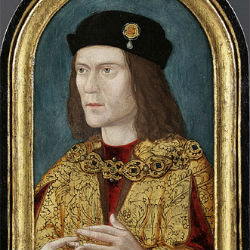
A skeleton in a 21st century car park. A king dragged off his horse and killed in 1485. How certain is the identification of one with the other?
The geneticists are working on the mitochondrial DNA (mtDNA) – the DNA that is passed down the generations through the female line. They have looked at the mtDNA in the skeleton; they have looked at the mtDNA in a living matrilineal descendant of Richard III’s mother. If the two match, the identification is certain. Or is it?
Mitochondrial DNA would not normally be the first choice for DNA profiling. There is a considerably higher probability of two random individuals sharing the same mitochondrial DNA profile than sharing the same standard forensic (autosomal DNA) profile. So it can be shared by people who are not closely related (through the maternal line) and it is not improbable that this can happen. But, on the other hand, mitochondrial DNA is undoubtedly the best choice for comparing two individuals separated by more than 500 years (if you believe they might be related through the maternal line). Firstly, it is passed faithfully down the female line, unchanged except for the occasional mutation. Secondly, maternal line ancestry is considerably more secure than paternal line ancestry; we can all be pretty sure who our biological mother is but paternity is somewhat more ‘leaky’ – the ‘Jeremy Kyle effect’. (The Jeremy Kyle TV show has revealed many unexpected paternities.)
The media have spoken of ‘proof’ and ‘confirmation’. Have the media got it right?
Well, not yet, it seems. Proof of a match in mitochondrial DNA is not necessarily proof that the skeleton is of the King.
Dr Turi King, the geneticist on the University of Leicester team, has confirmed the match of mitochondrial DNA. “The DNA sequence obtained from the Grey Friars skeletal remains was compared with the two maternal line relatives of Richard III. We were very excited to find that there is a DNA match between the maternal DNA from the family of Richard the Third and the skeletal remains we found at the Grey Friars dig.” She has carefully and properly NOT yet said that the skeleton is that of the king.

Structure of the human mitochondrial genome. Image by Shanel/Wikimedia.
DNA profiling evidence in courtrooms has a reputation as an infallible identifier of individuals. But it has to be treated rightly, and courts have to understand what it is saying in order to interpret it rightly. Generally, you have DNA at a crime scene, and DNA of a suspect; and the decision comes down to a contest between two competing explanations of an observed match: the prosecution would claim the match is because the crime scene DNA comes from the accused, the defence would argue that the match is just coincidence. Statisticians would judge the contesting claims on the basis of the likelihoods, and likelihood ratios are now routinely reported to courts.
That said, DNA profiling has achieved remarkable results. Its first ever use, led by its devisor Alec Jeffreys of the University of Leicester back in 1986, was in a double-murder case. It cleared an innocent man (he had made a false confession). And it identified the guilty man (who, fearing it, had paid a friend to provide a sample in his place.) It is a remarkable and a very useful tool.
In history as in courtrooms: it is a tool that, properly used, can help. But you have to understand that what it gives are statistical indications. And perhaps more importantly, mitochondrial DNA doesn’t have the discriminatory power of standard DNA profiling.
For a start, the University of Leicester team are still working on the genetic material. They have not announced their full results yet. Instead they have produced DNA sequences from only some parts of the mitochondrial molecule. Again, statistics rears it head. Mitochondrial DNA comes in different varieties – technically called haplotypes – and it is the haplotypes that are being compared. Some haplotypes are common, some are rare, and the more of the mitochondrial DNA you sequence, the better defined, and so rarer the haplotype will be.
Richard III may have had a common sort of haplotype; in which case many other 15th century men would have had it too. The skeleton might be any one of those men. Or he may have had a rare haplotype; in which case the number of candidates for the skeleton goes down, and the likelihood that it is indeed the King goes up. Thus the likelihood of the skeletal haplotype matching the known relatives is very high if the skeleton is the king (the probability of a match is not quite one because of the chance of a mutation, but is close to it). Under an alternative hypothesis that the skeleton is from an unrelated man, a reasonable value for the likelihood is the relative frequency of the haplotype in the general population.
We have not yet been told what haplotype the Leicester team have found. When they have completed their research, and have released their full data, we shall know. And if, as we can hope, it is a rare haplotype, the identification becomes that much more secure.
But even that evidence will not be conclusive; it will only provide statistical support, and, as with all evidence and indications, it should be considered in conjunction with all the other things that we know: the curvature of the spine, the battle-injuries; the age of the man at his death, and radio-carbon dating of the remains. All these and many others are relevant and there is little justification for privileging the DNA results.
‘We should remember three things’ says Mark Thomas, Professor of evolutionary genetics at University College London, who explained the above to me: ‘First, the genetics work is still in progress; second, media claims of certainty are exaggerated; and third, the genetic evidence should be taken only as support for the remains being those of Richard III. That degree of support should be re-assessed when the full data is in, and then in combination with the other data on the skeleton.’
Even when the full mtDNA is available there are likely to be one or two mismatches even if the claimed relationship is true. There may well have been mutations during the 528 years that have passed since 1485. This will make the analysis harder but more fruitful.
So we shall await, with some fascination, the full report from the Leicester team. As Professor Thomas points out, Turi King, who is leading the DNA work, is a highly reputable scientist and is in the same department as Sir Alec Jeffreys, the father of DNA fingerprinting, so she will not be short of good advice should she need it. Unfortunately, scientists rarely have much control on how the media reports their results.




